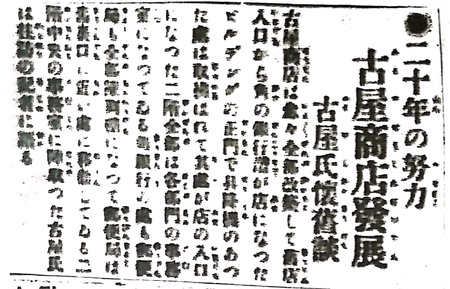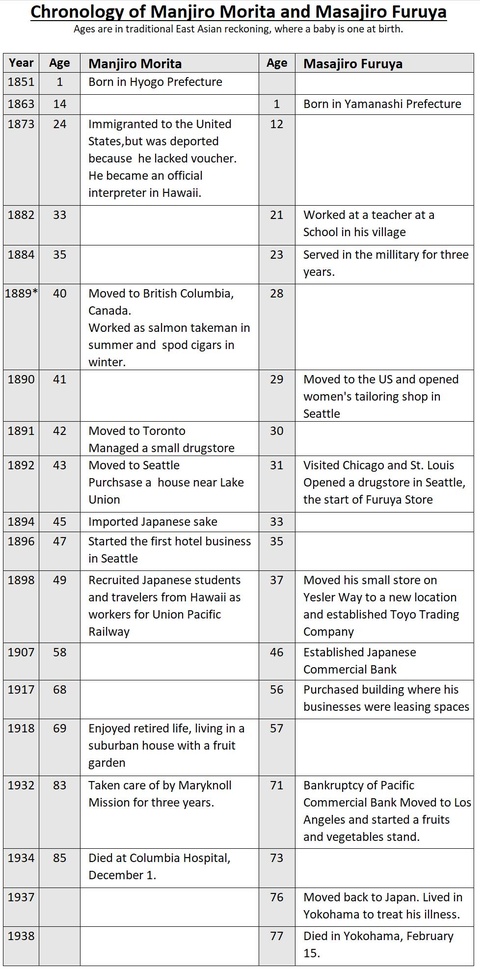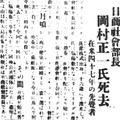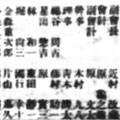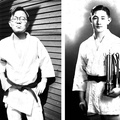The first chapter featured articles related to the early days of Seattle from around 1850. Here, the focus is Japanese immigrants who first went to Seattle around 1890.
The Pioneers of Japanese Businesses
Around 1890, Japanese people began landing in Seattle and starting various businesses. These individuals laid the foundations for later Japanese society in the area. The 1928 edition of the Hokubei Nenkan (North American Yearbook) introduces the pioneers of Japanese businesses in Seattle. Manjiro Morita and Masajiro Furuya are two who are profiled in The North American Times about their great achievements.
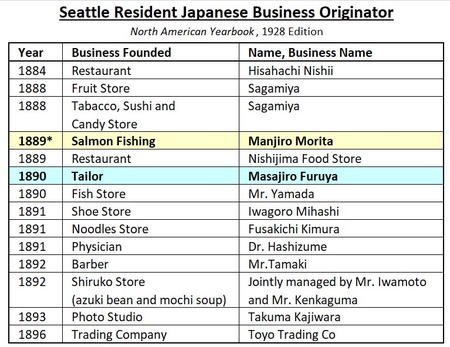
Manjiro Morita
In the November 2, 1934 issue, an obituary states that Manjiro Morita died at the age of 87. Morita was the oldest Japanese person living in Seattle at the time. According to the reference, he is said to have been a pioneer of Japanese businesses such as salmon fishing, general store management, innkeeping, etc. in Seattle and Canada. Along with the obituary, articles that look back on Morita’s achievements were published in three issues — November 2, 6, and 8. I will provide a summary of those articles.
Manjiro Morita died of pneumonia at Columbia Hospital yesterday at the age of 87. He was born on May 15, 1851 in Hyogo Prefecture. He first came to the United States in 1873, but because he did not have a passport, he was repatriated shortly after landing and served as an interpreter for the Hawaiian dynasty for a while.
In 1889*, at the age of 40, Morita moved to British Columbia, Canada to catch salmon in the Pacific Ocean in the summer and run a cigar shop in town during the winter. He continued this kind of life for about two years.
In 1891, Morita moved to Toronto, Ontario, eastern Canada, where he ran a small grocery store, but unfortunately, the store burned down in a fire.
It was in 1892 that Morita first came to Seattle. Around this time, Seattle was still a deserted rural village where boats were the only means of transportation. This made it difficult to travel to the countryside. Especially in the winter, there was a shortage of supplies, and food and supplies often ran out of stock. It was not easy for people who went to work in Alaska to spend the winter in Seattle. At that time, many Japanese in the United States were either sailors or bad-tempered people from Hawaii.
Morita bought land and a house on the shores of Lake Union and became a Seattle resident. He was the first Japanese to become a landowner in Seattle. Around this time, the population of the state of Washington was quite small and people were able to easily acquire land almost free as long as they filled out some simple paperwork. This was because the state wanted people to cultivate the land as quickly as possible.
In 1894, Morita imported Japanese sake from Japan. The U.S. government charged him a tremendous amount of tax because of the high alcohol content of sake. He was very fluent in English and it was said that nobody else could communicate with Americans like he could at that time. He was willing to serve as an interpreter to solve the problems that the Japanese community would face. Morita negotiated with the government himself and reached an agreement that lowered the import tax for sake to that of beer.
In 1896, Morita ran the first inn in Seattle called Cosmo House. As a community leader, he was the caretaker for everyone.
Around 1898, more young Japanese came to the United States as students than as sailors. Morita took some of those students and migrants from Hawaii to the state of Wyoming and referred them for work at the Union Pacific Railroad as contract laborers. As such, along the Pacific Coast, Morita played an active part on the front line of the Japanese pioneering era.
In his later years, he continued to be energetic and cultivated fruit trees in the suburbs of Seattle. He was under the care of Maryknoll (a Catholic mission) for the past three years.
The obituary published on November 2 includes the words “wife, Mary Morita.” She was French and stayed with Manjiro during his last years at Maryknoll. In the “Mitari Kiitari” (Seeing and Listening) section that was published three days later, there was a comment, “even though Morita lived to an old age, the death of such a great pioneer is very sad.”
Manjiro Morita was the among the first Japanese to fish for salmon in British Columbia. In Seattle, he was the first to own land, import sake from Japan, reduce taxes on it, and run an inn. None of the resources that I researched mention that he was the first Japanese to do the above five things. I didn’t know this until I read the North American Times archives. He was a great person of great achievements.
Masajiro Furuya
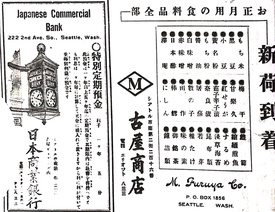
As mentioned in the last chapter, Furuya Shoten, founded by Masajiro Furuya, was a large department store selling Japanese groceries, furniture, daily home goods, works of art, books, shoes, etc. My grandmother had a receipt from 1934 for a futon she purchased from Furuya Shoten when she was running a barbershop in Seattle. Furuya expanded his business to the founding of the Toyo Trading Company and the Japanese Commercial Bank (later renamed Pacific Commercial Bank). He supported the Japanese community in Seattle.
In the May 21, 1918 North American Times, there is an article entitled “20 Years of Furuya Shoten Development” in which Mr. Furuya is interviewed.
About 20 years ago (1898) when I was 37, I moved from a small store on Yesler Way to this current building. The rent of the previous small store was 25 dollars, but this building was 75 dollars. Thankfully, business was growing and the store needed more space, so I rented the second floor together with the Nihonjinkai (Japanese Association). A few years later, I rented the entire basement and was paying 800 dollars for rent. In March of last year (1917), I purchased the building.
The bank and post office on the second floor had relocated to a nearby site, so I decided on a major renovation to accommodate the offices of the various departments. It cost a lot of money. It may have been cheaper to build a new building. I currently have 62 employees and the development of Furuya Shoten was slow compared to Seattle's development. I am deeply grateful to all of your support for our business.
The reporter who interviewed him said, “As usual, his happiness from his new building was apparent in his attitude when he spoke and that was a joyous thing.”
The change in rent may represent the progress of Furuya Shoten. The rent of 25 dollars for the first small store was about 50 Japanese yen at that time which is around 50,000 yen today. The rent of 800 dollars was about 1600 yen at that time which would be roughly 1.6 million yen ($15,000 US dollars) today. The fact that he was able to purchase the building after that reflects his tremendous success.
In the New Year’s issue of January 1, 1919, there is an editorial about the-then Prime Minister Takashi Hara. Hara had visited Seattle ten years before in 1909 and met with Japanese dignitaries in Seattle including Masajiro Furuya. A picture is attached to the editorial where Masajiro Furuya (48 years old at the time) is standing to the right of Hara. Whenever key figures from Japan visited, Furuya, representing Seattle Japanese immigrants, greeted them.

A North American Times reporter wrote that he discussed the contents of the editorial about the Prime Minister that New Year with Furuya. The humble Furuya replied, “people like me have no right to give advice.” Looking at the archives of the North American Times, it seems that Furuya was frequently interviewed; I found several articles with comments from him. Furuya must have always willingly agreed to such requests.
In an article on June 6, 1919, Dr. Robert Ezra Park, a professor at the University of Chicago who was a well-known scholar in the field of immigration at the time, praised Furuya Shoten as follows:
The Seattle compatriots are in an ideal state of development. Furuya's success story is the history of the progression of the Japanese people here. There is no other place that is developing so orderly.
The head office of Furuya Shoten was located in Seattle. It expanded its business to open stores in Portland, Tacoma, Vancouver B.C., Yokohama, and Kobe, making it the largest store of the Japanese community in the United States. It even became comparable to American department stores.
Masajiro Furuya died in Yokohama on February 15, 1938 at the age of 76. An obituary was written in the issue for that day, as follows:
In July of last year (1937), Masajiro Furuya had returned to Japan to recuperate from an illness. Furuya Shoten received a telegram today that Furuya died in Yokohama on February 15 at the age of 76. Furuya struggled during his childhood and after becoming a teacher in his village, he served in the military for three years. In April 1890, he moved to the United States at the age of 28, opened a women's tailor shop in Seattle, and ran a general store in 1892, which laid the foundation for Furuya Shoten. When he remodeled the current (1938) Pacific Commercial Building, Furuya Shoten moved to the current location. He expanded his business by opening branches in various cities and started a banking business.
After the bankruptcy of the Pacific Commercial Bank in 1931, he moved to Los Angeles and ran a grocery store (vegetable fruit market). He returned to Japan due to illness last July and was recuperating in Yokohama, but died of atrophic kidney disease. He was from Yamanashi Prefecture.
In Seattle, a memorial service was held at the Japanese Methodist Church, attended by nearly 400 people including Chusaburo Ito and Heiji Okuda, who had served as president of the Nihonjinkai as representatives of friends, as well as VIPs from various fields in Seattle. After Furuya’s death, the North American Times published a story every year about a memorial service that took place on the anniversary of his death and praised his great long-term achievements in the Seattle Japanese community from its early days to its development period.
Summary
Manjiro Morita and Masajiro Furuya both settled in Seattle in 1892 and played pioneering roles in the subsequent formation of the Japanese community in Seattle. As I mentioned in my previous chapter, Seattle was just a small town in 1890 with a population of 43,000. According to references, in February 1892, Furuya visited Chicago and St. Louis, then San Francisco and Los Angeles on his way back. As a result, he chose the undeveloped Seattle as the center for his life and business.
Since 1900, many Japanese have followed these pioneers and headed to Seattle to seek their own chance at success in business. The next chapter will feature articles about the development of Seattle as well as Japanese businesses after 1917.
*Editor's note: According to Hokubei nenkan (North American Yearbook), Mr. Morita started salmon fishing in 1888, but the North American Times mentioned that he started in 1889. This article uses the year 1889 as his starting of salmong fishing.
References
1. Hokubei nenkan (North American Yearbook), North American Current Affairs Company, 1928.
2. Jushiro Kato, Zaibei Doho Hattenshi (History of Brotherhood in the United States), Hakubunsha, 1908.
3. Kojiro Takeuchi, Beikoku seihokubu nihon iminshi (History of Japanese Immigrants in the Northwestern United States), Taihoku Nipposha, 1929.
*The English version of this series is a collaboration between Discover Nikkei and The North American Post, Seattle’s bilingual community newspaper.
© 2021 Ikuo Shinmasu


